Faculty Research
Explore ground-breaking research conducted by the faculty of the U.A. Whitaker College of Engineering (WCE). Projects that are hiring undergraduate and graduate students have a green "Currently Hiring" button.
- Department of Bioengineering, Civil Engineering, & Environmental Engineering
- Department of Computing & Software Engineering
- Stock Development Department of Construction Management
-
Particle Size Distribution Controls on Hydraulic Conductivity
Toggle More InfoParticle Size Distribution Controls on Hydraulic Conductivity
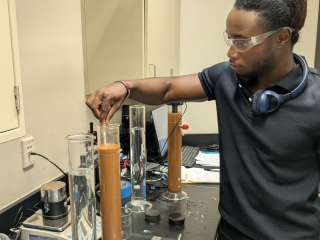
Faculty Member(s) Working on Project: Micheal Uduebor, Ph.D.
Student(s) Working on Project: Bellenste Forvil, Axel Cedeno Iznaga
Description: Accurate prediction of hydraulic conductivity from readily measurable soil properties remains a fundamental challenge in hydrogeology and geotechnical engineering. While traditional approaches rely on simplified grain size parameters (D10, uniformity coefficient), high-resolution particle size analysis offers the potential for more sophisticated predictive models. This study employs advanced particle size analysis to characterize geologically distinct soil samples from Florida, New Hampshire, Iowa, and North Carolina, coupled with laboratory hydraulic conductivity measurements.
Funding Source: WCE HeadStart Grant Program '24 - Determining Hydraulic Functions of Southwest Florida Soils
Funding Amount: $4,900
-
Soil Stiffness Modulus Correlations Between Two Field Test Methods
Toggle More InfoSoil Stiffness Modulus Correlations Between Two Field Test Methods
Faculty Member(s) Working on Project: Micheal Uduebor, Ph.D.
Student(s) Working on Project: Maxwell Petit, Alaga Begic
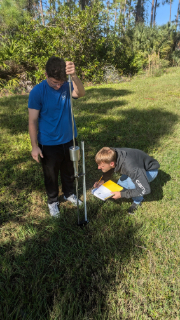
Description: The lightweight deflectometer (LWD) and dynamic cone penetrometer (DCP) are two tools commonly used in the geotechnical engineering industry to measure in-situ soil stiffness. Both tools enable the collection of field data, allowing engineers to make design decisions, as well as perform monitoring during the construction phase. As stiffness, or resistance to deflection and deformation under load, is an essential property of a well-performing soil, both tests are critical in ensuring the soil can distribute structural loads without failing. While both the LWD and DCP measure stiffness, they do so by different means. The DCP measures stiffness via recording resistance to penetration of a sharp steel tip driven in by a hammer drop, whereas the LWD measures deflection of a baseplate and underlying soil under a pulsed, dynamic load to calculate a stiffness modulus. Currently, there is no direct method to convert between these two test results.
Funding Source: WCE Start Up Grant
Funding Amount: $45,000
-
Nature-Based Infrastructure for Enhancing Climate Resiliency of Groundwater Resources in South Florida: An Integrated Modeling Approach
Toggle More InfoNature-Based Infrastructure for Enhancing Climate Resiliency of Groundwater Resources in South Florida: An Integrated Modeling Approach
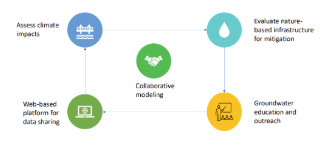
Faculty Member(s) Working on Project: Ahmed S. Elshall, Ph.D.; Mewcha Gebremedhin; Seneshaw Tsegaye, Ph.D.; and Rachel Rotz
Description: The project aims to evaluate and implement nature-based infrastructure features (NBIFs) that mitigate the effects of climate change on groundwater resources using an integrated modeling approach. Project Website
Funding Source: U.S. Environmental Protection Agency (EPA)
Funding Amount: $649,817
Outside Organizations Collaborating on Project: Florida State University (FSU), University of Florida (UF), United States Geological Survey (USGS), South Florida Water Management District (SFWMD), and City of Naples
-
A Model-Experiment (ModEx) Framework to Advance Understanding of Fertilizer and Pesticide Reactive Transport in Rural Agricultural Areas
Toggle More InfoA Model-Experiment (ModEx) Framework to Advance Understanding of Fertilizer and Pesticide Reactive Transport in Rural Agricultural Areas
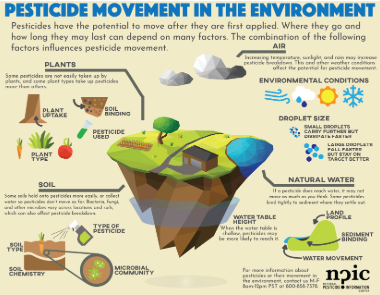
Faculty Member(s) Working on Project: Ahmed Elshall, Ph.D. and Mewcha Gebremedhin
Description: This project concerns fertilizers and pesticides used in the agricultural industry. South Florida is an important region of Florida’s $120 billion agriculture industry and produces 100% of Florida’s sugarcane, 42% of its vegetables, and 38% of its citrus. The goal of the project is to develop a ModEx framework that integrates models and experiments (field and lab) not only to advance our understanding on reactive transport of agricultural fertilizers and pesticides but also to help support the protection of children’s health and to help promote environmental justice and climate resiliency in rural agricultural areas.
Funding Source: U.S. Environmental Protection Agency (EPA)
Funding Amount: $595,025
Outside Organizations Collaborating on Project: Florida State University (FSU) and University of Florida (UF)
-
Explore a New Model-Data Framework to Advance Predictions of Red Tide for Addressing its Impact on Respiratory Illnesses Under Changing Temperature
Toggle More Info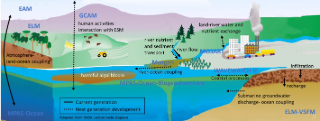
Faculty Member(s) Working on Project: Ahmed Elshall, Ph.D. and Michael Parsons
Description: This project explores a model-data framework that advances predictions of red tide events and their impact on respiratory illnesses in coastal communities under changing temperature conditions. The research involves an interdisciplinary team analyzing spatial and temporal data on red tide occurrences and respiratory health to discern dynamic relationships.
Funding Source: U.S. National Science Foundation (NSF)
Funding Amount: $107,702 to FGCU and $192,927 to FSU
Outside Organizations Collaborating on Project: Florida State University (FSU)
-
AI and Future of Higher Education: A Student-Centered Perspective
Toggle More InfoAI and Future of Higher Education: A Student-Centered Perspective
Faculty Member(s) Working on Project: Ahmed Elshall, Ph.D.; Ashraf Badir, Ph.D., P.E.; and Mewcha Gebremedhin
Description: The project explores how advances in generative AI are changing student learning. This project contributes to an emerging paradigm where AI is not simply a support tool but a cognitive partner demanding a rethinking of student and instructor roles. This calls for a forward-looking educational design that enables STEM students to thrive in an AI-driven future.
-
Evaluation and Optimization of Combined Trickling Filters with Aeration and Passive Floating Treatment Wetlands for Pre-Treatment of Waste-to-Energy Ash Influenced Class I Landfill Leachate to Meet Domestic Treatment Works Discharge Requirements
Toggle More InfoEvaluation and Optimization of Combined Trickling Filters with Aeration and Passive Floating Treatment Wetlands for Pre-Treatment of Waste-to-Energy Ash Influenced Class I Landfill Leachate to Meet Domestic Treatment Works Discharge Requirements
Faculty Member(s) Working on Project: Ashley Danley, Ph.D., P.E., and Sim Komisar, Ph.D.
Student(s) Working on Project: Iris Dorn, Lucas Perfetto, Carter Baker
Description: This study explores a low-cost, low-maintenance hybrid system—floating wetlands, trickling filters, and aeration—to treat landfill leachate (garbage juice). The goal is to lower pollutant concentration (inorganic nitrogen and chemical oxygen demand) before discharge to a wastewater treatment facility, while giving landfill managers practical design criteria that cut costs and meet discharge requirements.
FGCU has studied phytoremediation of leachate for years, but combining it with aeration and trickling filters has not been explored. This approach merges natural plant-based treatment with engineered biological and physical processes. Floating wetlands can be added to existing onsite leachate storage ponds with little disruption, while aeration and trickling filters may boost removal of nitrogen, COD, and metals—especially in leachate affected by waste-to-energy ash. Though used in greywater and wastewater treatment, this combined system is novel for landfill leachate. Open questions remain about plant lifespan, maintenance needs, and disposal of spent plants, which are key to making the system practical and cost-effective.Funding Source: Hinkley Center for Solid and Hazardous Waste
Funding Amount: $55,000
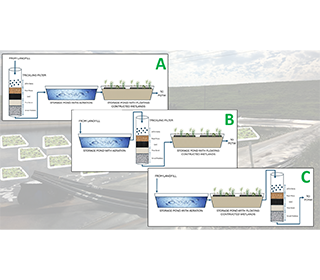
-
Design and Fabrication of Microfluidic Chips for Tapered Optical Fiber Based Biosensors
Toggle More InfoDesign and Fabrication of Microfluidic Chips for Tapered Optical Fiber Based Biosensors
Faculty Member(s) Working on Project: Marzhan Sypabekova, Ph.D., and Derek Lura, Ph.D.
Student(s) Working on Project: Alba Lako (graduated), Gus Brugger, Rigoberto Tovar
Description: This project designs, fabricates, and tests microfluidic chip architectures that integrate and protect tapered optical fibers. Chip variants span channel geometry, inlet/outlet layout, fiber alignment and anchoring features, encapsulation methods, and substrate/material choices. Performance is quantified via refractive-index (RI) sensing tests to assess evanescent-field interaction, stability, response time, repeatability, and optical coupling efficiency under continuous flow. The fibers are biofunctionalized using robust surface-chemistry routes (e.g., silanization and monolayer formation followed by aptamer/antibody immobilization) to enable selective biomarker detection, and chips are benchmarked for signal-to-noise ratio, limit of detection, and regeneration consistency. The outcome is a validated set of chip designs with documented trade-offs for RI-based and biofunctionalized tapered-fiber biosensing.
Funding Source: Startup Package
-
Periodontal Biosensor Development for Detection of Peri-Implantitis
Toggle More InfoPeriodontal Biosensor Development for Detection of Peri-Implantitis
Faculty Member(s) Working on Project: Marzhan Sypabekova, Ph.D., and Sarkis Sozkes, Ph.D.
Description: This project develops a fiber-optic biosensor to detect early peri-implantitis by quantifying the inflammatory biomarker MMP-8. Activities include ELISA-based antibody validation, surface functionalization of tapered optical fibers, sensor fabrication and calibration in clinically relevant ranges, and specificity/sensitivity testing to generate a prototype and pilot data.
Funding Source: WCE HeadStart Grant
Funding Amount: $5,000
-
Development and Validation of an Alveolar Lung-on-a-Chip Model
Toggle More InfoDevelopment and Validation of an Alveolar Lung-on-a-Chip Model
Faculty Member(s) Working on Project: Marzhan Sypabekova, Ph.D.
Student(s) Working on Project: Nicholas Blanco, Peyton McCarthy, Sidney Dascani
Description: This project builds an alveoli-on-a-chip using a 3D-printed, biocompatible resin microfluidic chip that houses a porous membrane to recreate the alveolar–capillary interface. The upper channel supports an air–liquid interface epithelium, while the lower channel perfuses lung microvascular endothelium; a flexible membrane enables cyclic strain to mimic breathing. The printed geometry provides optical access and standardized ports for controlled flow.
Funding Source: Department funds, Brodie Scholarship (awarded to Peyton McCarthy)
-
Reimagining the JFK Assassination in the Smartphone Era: AI-Driven Analysis of Historical Footage and Crowd Dynamics
Toggle More InfoReimagining the JFK Assassination in the Smartphone Era: AI-Driven Analysis of Historical Footage and Crowd Dynamics
Faculty Member(s) Working on Project: Md Baharul Islam, Ph.D. (PI); Judd Cribbs (Co-PI); Sudip Dhakal, Ph.D. (Co-PI)
Student(s) Working on Project: Sahbah Gonzalez
Description: The assassination of President John F. Kennedy in 1963 remains one of the most visually iconic and publicly scrutinized events of the 20th century. While the Zapruder film provides the only continuous record of the assassination, additional amateur films exist but suffer from distance, grain, shakiness, and obscured sightlines. In the contemporary digital era, the same event would likely be captured by hundreds of smartphones and instantly disseminated across social media platforms. This project proposes to merge computer vision and AI techniques with media studies to reimagine how the Kennedy assassination might have been recorded today. The research will (a) enhance poor-quality archival films, (b) apply AI to detect and count spectators frame by frame, (c) analyze crowd distribution in Dealey Plaza, and (d) model how many smartphone recordings would exist in today’s media environment. The outcomes will provide both technical innovations in archival video restoration and scholarly insights into how technology alters the public witnessing of history.
Funding Source: WCE HeadStart Grant Program
Funding Amount: $5,000
Outside Organizations Collaborating on Project: Department of Communication and Philosophy, FGCU
-
SignifyAR: An Augmented Reality-Based Platform for Real-Time Multilingual Sign Language Interpretation
Toggle More InfoSignifyAR: An Augmented Reality-Based Platform for Real-Time Multilingual Sign Language Interpretation
Faculty Member(s) Working on Project: Md Baharul Islam, Ph.D.
Student(s) Working on Project: Saif Simanta
Description: The proposed project, SignifyAR, aims to design and prototype an innovative, AI-enabled Augmented Reality (AR) system that facilitates real-time multilingual sign language interpretation. This project addresses a critical gap in inclusive communication technologies by integrating computer vision, deep learning, and AR interfaces to support seamless interaction between signers and non-signers. The system will capture sign language gestures through a camera, process them using deep learning models, and render interpretations using animated avatars or textual overlays via an AR headset or mobile device. This collaborative, faculty-led research initiative will engage undergraduate student researchers in both the software engineering and cognitive interface design components of the system. The interdisciplinary team will include collaborators from Computing and Software Engineering, Psychology, and external partners from the Sally J. Pimentel Deaf and Hard-of-Hearing Center in Fort Myers. Students will gain hands-on experience in dataset annotation, model training, AR integration, and usability testing. The expected outcomes of this 17-month project include (1) development of a high-fidelity prototype of SignifyAR, (2) submission of at least one peer-reviewed conference paper and one journal article, and (3) preparation of a competitive external funding proposal targeting the NSF Smart and Connected Communities or IUSE program. The Holmes Fund award will support student stipends, hardware for AR testing, and travel to disseminate research findings.
Funding Source: Whitaker Institute for STEM Education (Holmes Development Fund)
Funding Amount: $10,000
-
Enhanced Perception to Overcome Visual Field Defects: A Multi-Modal AR/MR-based Visual Aid
Toggle More InfoEnhanced Perception to Overcome Visual Field Defects: A Multi-Modal AR/MR-based Visual Aid
Faculty Member(s) Working on Project: Md Baharul Islam, Ph.D.
Student(s) Working on Project: Jack Leser, Ian Wong
Description: The ultimate goal of this project is to break new ground in HMD-based visual aids by developing an XR-based system to maximize the perception of people with VFL (moderate to severe) from their surroundings.
Funding Source: WiSER RA and WCE GA
Funding Amount: Two assistantships
-
Head-Start: Quantum Reinforcement Learning for Real-Time UAV-Aided Post-Disaster Transportation Infrastructure Resilience
Toggle More InfoHead-Start: Quantum Reinforcement Learning for Real-Time UAV-Aided Post-Disaster Transportation Infrastructure Resilience
Faculty Member(s) Working on Project: Chengyi Qu, Ph.D. (PI) and Jieyi Bao, Ph.D. (Co-PI)
Student(s) Working on Project: Gabriella Vallar, Ishita Chakkalakkal
Description: This proposal seeks to develop an integrated quantum reinforcement learning (QRL) based framework for real-time UAV-aided roadway and pavement reconstruction after hurricanes. The proposed research builds upon preliminary work in which Generative AI (GenAI) has been employed to synthesize diverse pre-disaster scenarios, enabling models to be pre-trained on a wide range of possible damage conditions. The central challenge addressed here is that post-hurricane roadway assessment and reconstruction planning involve complex decision-making in dynamic, large-scale environments with real-time constraints. Formally, the optimization problem underlying UAV path planning, dynamic data processing, and structural modeling is NP-hard due to its combinatorial nature, the evolving conditions of disaster sites, and the exponential growth in the state-action space when classical reinforcement learning is applied. By introducing QRL techniques, this project aims to reduce the computational complexity from exponential to near-polynomial levels, thereby enabling real-time decision-making for large-scale post-disaster reconstruction efforts. Also, UAV-collected data and QRL-based reconstruction strategies will be integrated into Building Information Modeling/Geographic Information Systems (BIM/GIS) platforms to support intuitive visualization and management, serving as a practical prototype toward future digital twin development.
Funding Source: WCE HeadStart Grant Program
Funding Amount: $5,000
-
Hierarchical AI-Driven and Multimodal Security Framework for Smart Homes in Senior Communities
Toggle More InfoHierarchical AI-Driven and Multimodal Security Framework for Smart Homes in Senior Communities
Faculty Member(s) Working on Project: Chengyi Qu, Ph.D.
Student(s) Working on Project: Sean Peppers, Oliver Ostlander
Description: Beyond technical advancements, this project will have a transformative impact on digital security for aging communities by establishing a long-term cybersecurity research and education platform in collaboration with the Shady Rest Institute of Positive Aging and other senior-focused organizations. This platform will provide seniors with interactive cybersecurity workshops, incorporating hands-on experiences with smart home security tools, real-time threat awareness demonstrations, and personalized cybersecurity guidance based on multimodal behavioral data. By directly involving seniors in cybersecurity training, the project aims to bridge the gap between advanced security research and real-world adoption. Additionally, this project will integrate multimodal AI-driven cybersecurity concepts into undergraduate and graduate curricula, allowing students to engage in interdisciplinary research that combines IoT security, AI-driven multimodal analysis, and human-centered cybersecurity design. To further extend its outreach, the project will also develop educational modules for K-12 students, introducing fundamental smart home security and AI concepts through interactive learning experiences that emphasize privacy, security, and AI ethics. By combining research, education, and community engagement, this project will not only deliver cutting-edge security solutions for smart homes but also establish a scalable, sustainable model for AI-driven security education. Ultimately, by enhancing cybersecurity awareness and protection in aging populations while cultivating the next generation of security experts, this project will contribute to a safer and more intelligent senior-friendly digital ecosystem.
Funding Source: WiSER Program
Outside Organizations Collaborating on Project: Shady Rest Institute of Positive Aging
-
Multimodal Object Detection Using Camera, LiDAR, and Radar for Autonomous Driving
Toggle More InfoMultimodal Object Detection Using Camera, LiDAR, and Radar for Autonomous Driving
Faculty Member(s) Working on Project: Sudip Dhakal, Ph.D. (Co-PI) and Md Baharul Islam (Co-PI)
Student(s) Working on Project: Sebastian Campos, Ehud Orenstain
Description: Autonomous driving systems require highly reliable perception frameworks to detect and
classify objects under diverse environmental conditions. Current multimodal systems
integrating cameras and LiDAR have advanced the field substantially, but they still face
notable limitations. Cameras are affected by poor lighting and adverse weather, while
LiDAR struggles with sparse point clouds at longer ranges.
Radar sensors offer a complementary solution, with strong resilience to adverse weather,
long-range coverage, and inherent velocity estimation capabilities. Although radar has
been extensively studied in defense applications, its integration into civilian autonomous
driving perception frameworks remains underexplored.
This project seeks to build upon prior multimodal detection work by incorporating radar
as an additional modality into a fusion-based object detection framework, thereby
advancing FGCU’s footprint in cutting-edge research on autonomous systems.Funding Source: WCE HeadStart Grant Program
Funding Amount: $5,000
-
Investigate AI Application in Electrical Construction
Toggle More InfoInvestigate AI Application in Electrical Construction
Faculty Member(s) Working on Project: Andy Chau, Ph.D., P.E.; Anna Koufakou, Ph.D.; Long Nguyen, Ph.D., P.E.
Student(s) Working on Project: John Holik
Description: This project aims to explore the integration of AI within the electrical construction industry, addressing the growing need for intelligent tools that can assist in tasks such as interpreting electrical codes, managing submittals, and cross-checking procedures. Electrical contractors face increasing complexity in their operations, and the ability to leverage AI-driven tools can significantly enhance efficiency and reduce errors. The target audience for this research includes electrical contractor executives, project managers, and industry professionals who stand to benefit from the practical applications of AI in their workflows.
-
AccessiBIMlity
Toggle More InfoAccessiBIMlity
Faculty Member(s) Working on Project: Marina Figueiredo Muller, Ph.D.
Student Worker(s) Working on Project: Leonardo Bacile
Description: This project aims to propose a method to develop tactile maps for people with blindness or visual impairment. Building information models (BIM) can be used to support this process, since the platform allows for extraction and interoperability with 3d printing formats.
Funding Source: WCE HeadStart Grant Program '22
Funding Amount: $5,000
Outside Organizations Collaborating on Project: First Baptist Church of Curitiba
-
REX - From Paper to BIM
Toggle More InfoREX - From Paper to BIM
Faculty Member(s) Working on Project: Marina Figueiredo Muller, Ph.D. and Raissa Marchiori, Ph.D.
Description: The evolution of project tools, from the pre-paper era to CAD and BIM systems, leads to the question of whether these concepts are fully absorbed by engineering students. A classroom dynamic was proposed to enable students to interact with the process of transitioning between tools. The goal was to develop an activity to teach project tools. This activity was designed based on bibliographic research about project tools and was validated through a survey completed by groups of participants consisting of undergraduate students (with no prior design knowledge) and graduate professionals in engineering. The results demonstrate that the REX dynamic facilitates the consolidation of the learning process.
Outside Organizations Collaborating on Project: University of Louisiana Monroe - Dr. Clint Martin
-
Uncovering Contributing Factors of Electric Vehicle Crashes Through Advanced Data-Driven Analysis
Toggle More InfoUncovering Contributing Factors of Electric Vehicle Crashes Through Advanced Data-Driven Analysis
Faculty Member(s) Working on Project: Jieyi Bao, Ph.D.
Description: The rapid growth of Electric Vehicle (EV) adoption has introduced unique safety challenges due to their greater weight, faster torque response, quieter operation, and risk of post-crash battery fires, which may alter crash dynamics and severity. Studies indicate elevated risks in certain scenarios, particularly from mass-related kinetic energy and thermal runaway hazards, yet most crash analyses focus on conventional vehicles, with EV-specific patterns remaining underexplored. Current databases also provide limited distinction between EVs and internal combustion vehicles, constraining insights into roadways, drivers, and vehicle-related factors. This study applies advanced data-driven analytics to address this gap, uncovering hidden relationships in crash data to improve roadway safety and inform infrastructure planning.
Funding Source: WCE HeadStart Grant Program
